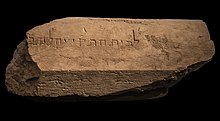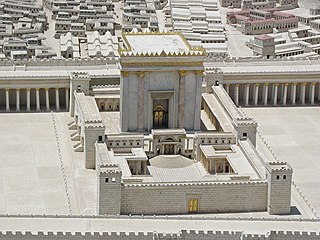
The Second Temple, later known as Herod's Temple, was the reconstructed Temple in Jerusalem between c. 516 BCE and 70 CE. Defining the Second Temple period, it stood as a pivotal symbol of Jewish identity and was central to Second Temple Judaism; it was the chief place of worship, ritual sacrifice (korban), and communal gathering for Jews. As such, it attracted Jewish pilgrims from distant lands during the Three Pilgrimage Festivals: Passover, Shavuot, and Sukkot.

Benjamin Mazar was a pioneering Israeli historian, recognized as the "dean" of biblical archaeologists. He shared the national passion for the archaeology of Israel that also attracts considerable international interest due to the region's biblical links. He is known for his excavations at the most significant biblical site in Israel: south and south west of the Temple Mount in Jerusalem. In 1932 he conducted the first archaeological excavation under Jewish auspices in Israel at Beit She'arim and in 1948 was the first archaeologist to receive a permit granted by the new State of Israel. Mazar was trained as an Assyriologist and was an expert on biblical history, authoring more than 100 publications on the subject. He developed the field of historical geography of Israel. For decades he served as the chairman of the Israel Exploration Society and of the Archaeological Council of Israel. Between 1951 and 1977, Mazar served as Professor of Biblical History and Archaeology at the Hebrew University of Jerusalem. In 1952 he became Rector of the university and later its president for eight years commencing in 1953.

Jattir is a town in Judea mentioned several times in the Hebrew Bible. It was known as Iethira during the 4th century CE, when it was a Christian town. It is identified with Horvat Yattir/Khirbet Attir, an archeological site in the southern Hebron Hills, located in modern day Israel.

Eilat Mazar was an Israeli archaeologist. She specialized in Jerusalem and Phoenician archaeology. She was also a key person in Biblical archaeology noted for her discovery of the Large Stone Structure, which she surmised to be the palace of King David.

Ben Shemen is a moshav in central Israel. Located around four kilometres east of Lod, it falls under the jurisdiction of Hevel Modi'in Regional Council. In 2022 it had a population of 881.

Tel Maresha is the tell of the biblical Iron Age city of Maresha, and of the subsequent, post-586 BCE Idumean city known by its Hellenised name Marisa, Arabised as Marissa (ماريسا). The tell is situated in Israel's Shephelah region, i.e. in the foothills of the Judaean Mountains, about 2 kilometres (1.2 mi) southeast of Beit Gubrin.

Beit She'arim necropolis is an extensive necropolis of rock-cut tombs near the remains of the ancient Jewish town of Beit She'arim. In early modern times the site was the Arab village of Sheikh Bureik; it was depopulated in the 1920s as a result of the Sursock Purchases, and identified as Beit She'arim in 1936 by historical geographer Samuel Klein.
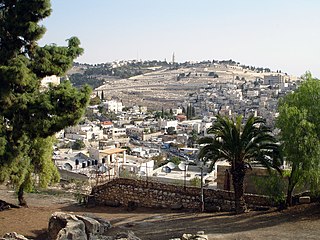
Ophel is the biblical term given to a certain part of a settlement or city that is elevated from its surroundings, and probably means fortified hill or risen area. In the Hebrew Bible, the term is used about two cities: Jerusalem, as in 2 Chronicles 27:3 and 33:14 and Nehemiah 3:26 and 11:21, and Samaria, mentioned in 2 Kings 5:24. The Mesha Stele, written in Moabite, a Canaanite language closely related to Biblical Hebrew, is the only extra-biblical source using the word, also in connection to a fortified place.

Gedaliah, son of Pashhur, is a man described in the Book of Jeremiah of the Hebrew Bible, Judaism's Tanakh, and Christianity's Old Testament. He is described as one of the political opponents of Jeremiah, one of those who appealed to King Zedekiah to have Jeremiah executed because of his prophecies that Jerusalem and the Temple would be destroyed by the Babylonians due to the wickedness of the Jews:
1 And Shephatiah the son of Mattan, and Gedaliah the son of Pashhur, and Jucal the son of Shelemiah, and Pashhur the son of Malchiah, heard the words that Jeremiah spoke unto all the people, saying: 2 Thus saith the LORD: He that remaineth in this city shall die by the sword, by the famine, and by the pestilence; but he that goeth forth to the Chaldeans shall live, and his life shall be unto him for a prey, and he shall live. 3 Thus saith the LORD: This city shall surely be given into the hand of the army of the king of Babylon, and he shall take it.' 4 Then the princes said unto the king: 'Let this man, we pray thee, be put to death; forasmuch as he weakeneth the hands of the men of war that remain in this city, and the hands of all the people, in speaking such words unto them; for this man seeketh not the welfare of this people, but the hurt.'.

Robinson's Arch is the name given to a monumental staircase carried by an unusually wide stone arch, which once stood at the southwestern corner of the Temple Mount. It was built as part of the expansion of the Second Temple initiated by Herod the Great at the end of the 1st century BCE. Recent findings suggest that it may not have been completed until at least 20 years after his death. The massive stone span was constructed along with the retaining walls of the Temple Mount. It carried traffic up from ancient Jerusalem's Lower Market area and over the Tyropoeon street to the Royal Stoa complex on the esplanade of the Mount. The overpass was destroyed during the First Jewish–Roman War, only a few decades after its completion.
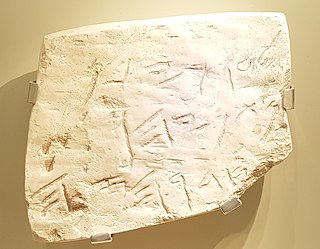
Khirbet el-Qom is an archaeological site in the village of al-Kum, West Bank, in the territory of the biblical Kingdom of Judah, between Lachish and Hebron, 14 km (8.7 mi) to the west of the latter.

Benjamin Henri Isaac is the Fred and Helen Lessing Professor of Ancient History Emeritus at Tel Aviv University. He is a member of the Israel Academy of Sciences and Humanities and of the American Philosophical Society

Hyrcania was an ancient fortress in the Judean Desert. It was built by Hasmonean ruler John Hyrcanus or his son Alexander Jannaeus in the 2nd or 1st century BCE. The fortress was rebuilt and greatly expanded by King Herod. After Herod's death Hyrcania was abandoned, only to be resettled during the Byzantine period, when a late-5th century monastery named Kastellion was established on the ruined fortress, which remained active until the early 9th century. There was a short-lived attempt by monks to rebuild in the 1920s-30s. The ancient ruins can still be seen today.

The Royal Stoa was an ancient basilica constructed by Herod the Great during his renovation of the Temple Mount at the end of the first century BCE. Probably Herod's most magnificent secular construction, the three-aisled structure was described by Josephus as deserving "to be mentioned better than any other under the sun." A center of public and commercial activity, the Royal Stoa was the likely location of Jesus' cleansing of the Temple recounted in the New Testament. The Royal Stoa overlooked Jerusalem's residential and commercial quarters, and at its southwestern corner was the place from which a ram's horn was blown to announce the start of holy days.
The Monastery of the Virgins is a structure uncovered during Benjamin Mazar's excavations south of Jerusalem's Temple Mount. The large number of Christian religious finds from the site have prompted its identification with a monastery described by a pilgrim, Theodosius the archdeacon, in his De Situ Terrae Sanctae, a work of the early 6th century. The building was constructed in the 4th century on the remains of an earlier Herodian building identified with the Second Temple courthouse, and was destroyed during the Persian sack of Jerusalem in 614.
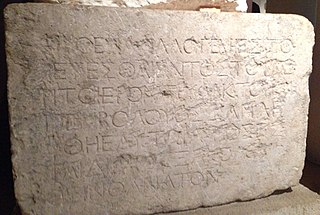
The Temple Warning inscription, also known as the Temple Balustrade inscription or the Soreg inscription, is an inscription that hung along the balustrade outside the Sanctuary of the Second Temple in Jerusalem. Two of these tablets have been found. The inscription was a warning to pagan visitors to the temple not to proceed further. Both Greek and Latin inscriptions on the temple's balustrade served as warnings to pagan visitors not to proceed under penalty of death.
Corpus Inscriptionum Iudaeae/Palaestinae (CIIP) is a corpus of all ancient inscriptions from the fourth century BC to the seventh century CE discovered in Israel – i.e. “a multi-lingual corpus of the inscriptions from Alexander to Muhammad.” Part 1 of Volume 1 was published in 2010, and Part 2 of Volume 1 in 2012.

Several kinds of archaeological remnants of the Jerusalem Temple exist. Those for what is customarily called Solomon's Temple are indirect and some are challenged. There is extensive physical evidence for the temple called the Second Temple that was built by returning exiles around 516 BCE and stood until its destruction by Rome in the year 70 CE. There is limited physical evidence of Solomon's Temple, although it is still widely accepted to have existed.
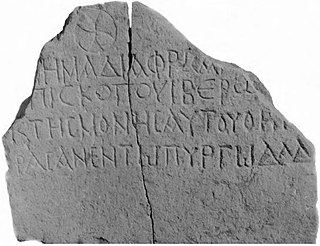
The Epitaph of Samuel is an Ancient Greek limestone tombstone slab epitaph inscription which was discovered in 1934, in the monastic cemetery of the Byzantine period, at the YMCA area in Jerusalem.

Tel Zeton (Hebrew: תל זיתון, also known as Tell Abu Zeitun, is an archaeological site in the Pardes Katz neighborhood of Bnei Brak, Israel. It lies 800 m south of the Yarkon River. The mound rises to a height of 9 m above its surroundings and spans an area of 2–3 dunams. The site was inhabited in the Middle Bronze Age and later in the Iron and Persian periods. Jacob Kaplan identified the fortified settlement from the Persian period as a Jewish settlement from the time of the Return to Zion in the 5th century BCE, thanks to an ostracon bearing a Hebrew name which appears in the Hebrew Bible from the time of Nehemiah, a Jewish governor appointed by the Achaemenid Empire to govern the autonomous Jewish province. The site was inhabited as late as the 10th century CE, during the Roman, Byzantine, Early Arab, and Mamluk periods.
